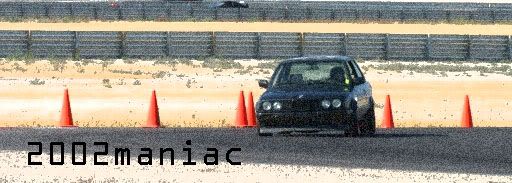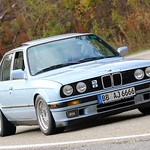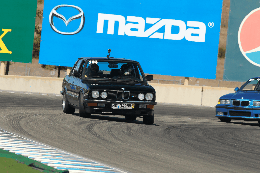Agreed. I won't engage in the type of "negative marketing" that others seem to relish, because it only makes the mud slinger himself look bad. I'd rather talk about the benefits and pluses of our products rather than linger on the well documented failures in someone else's products.


That video test is indeed very "unscientific", and utterly meaningless, as we have too much real world results to take much stock in it. We use that same model bearing holder on 12 different camber plate designs and have sold thousands of them since 2003, both under MotorForce and under Vorshlag afterward (Vorshlag bought the products, designs and inventory from Motorforce Engineering in January 2006. I am the sole owner at Vorshlag). We've never seen one MF or Vorshlag bearing holder break, ever. They've been used on countless street cars, track cars, auto-x cars, even rally cars. Zero breakage is fact - not some made-up, silly, teeter-totter demonstration. We don't have an axe to grind, just want to share the flawless, real world experience with this bearing holder.
We've also only seen 2-3 of our E30 camber plates "main plate" that have ever bent with our current E30 design (made for the past several years), and those all happened after big crashes that heavily damaged the chassis. So we won't be changing anything in our bearing holder or main plate design - because they have proven themselves after many years of service on hundreds of cars.

We also feel that our E30 design has ample negative camber travel (we've measured -4° on several E30s on multiple alignment racks), but I will concede that the newest GC design potentially has more inboard travel. Going with the counter sunk flush head bolts from the bearing holder to the main plate allows for top of the strut to slide inboard another 1/8" to 1/4", like our E36, E90, EVO X, and both of our E46 versions do. Kudos to GC for updating their design in that aspect. :)
There's some question about stack-up height on our plates. Here's a few tech articles we've had on our website (and on motorforce's before ours) to explain more about bump travel and stack-up height:
I'll post the pictures below to show two versions of our E30 camber plate. This isn't the textbook correct way to measure stack-up height of a camber plate, its just the way that someone else here measures it (proper stack-up height is measured from the top of the plate to the point on the bottom of the perch where the bump stop contacts).


On the second linked article above we show the stack-up height of some stock E36 strut top mounts, and the E30 is almost identical to the 95 M3 version shown, which are 53-55mm thick. As you can see the stack-up height of our E30 plates with coilover perches are shorter than stock, which is what is wanted to allow for more suspension travel.
Without getting into another competitor's dirty laundry, I will say this: we've sold thousands of camber plates but have only had to replace spherical bearings 3 or 4 times, ever. There was something strange about the use or situation in all of those cases, too. I don't think anyone else on the planet that makes camber plates can claim that low of a level of bearing replacement rate. This is due to two main factors: size of the spherical bearing and the unique upper spring perch/radial bearing design.

The spherical bearing we have always used in every camber plate design, since MotorForce days through today, are 3/4" (19mm) ID bearings from two name brand, US manufacturers. This is the bearing shown above, left. We now have them custom made to order in the USA, to our specs, and they are expensive. Most other camber plate designs built for BMWs on the market use a 5/8" ID (~16mm) ID spherical bearing, as typified by the picture above, right. The picture of a 3/4" and 5/8" spherical shown side by side is hardly a libelous action, by the way, just a plain old picture - that perhaps speaks volumes.
You can read the tech article linked above to see the impact loads that each size bearing can withstand before it fails, and impact load is what matters in a spherical bearing (cars never see thousands of pounds of static load). In this case - size really does matter.


Now having a bigger, stronger, more expensive spherical bearing is only part of why our camber plates are silent, trouble-free, and outlast the car. The other crucial aspect is the isolation of radial/turning loads on the spherical bearing, through a sealed radial bearing pressed into the unique upper spring perch, sold with all of our camber plates. This is a more complicated and expensive way to make a camber plate, but its the only maintenance-free method we have seen that works, for both race or street vehicles.


Our sealed radial bearings are rugged, reliable, and trouble-free. Unlike an unsealed flat radial bearing, these sealed units cannot have the grease washed out from the rollers in rain, cannot have road grime and dirt score the rollers and lock up the radial bearing, and they don't have to be removed and re-greased regularly. When a radial bearing locks up it causes popping and stiction in the steering wheel when the car is turned. Then the rotation of the strut shaft travels through the spherical bearing, which was never meant to handle turning loads. This causes a spherical bearing to fail quickly, no matter of strong it is. A spherical bearing is only made to handle axial pivoting, not turning.
Yes, our camber plates usually cost more than many others on the market. Hopefully my explanations above have shown why - sometimes a more expensive product has a cost that is justified. OK, that's most of what I posted before, and all I'm going to say until more real questions from other people pop up here. We've got real tech to back up every aspect of our products, and don't need to use cheap shots or parlor tricks to prove why our products are rugged and worth the cost. :D
Cheers,


That video test is indeed very "unscientific", and utterly meaningless, as we have too much real world results to take much stock in it. We use that same model bearing holder on 12 different camber plate designs and have sold thousands of them since 2003, both under MotorForce and under Vorshlag afterward (Vorshlag bought the products, designs and inventory from Motorforce Engineering in January 2006. I am the sole owner at Vorshlag). We've never seen one MF or Vorshlag bearing holder break, ever. They've been used on countless street cars, track cars, auto-x cars, even rally cars. Zero breakage is fact - not some made-up, silly, teeter-totter demonstration. We don't have an axe to grind, just want to share the flawless, real world experience with this bearing holder.
We've also only seen 2-3 of our E30 camber plates "main plate" that have ever bent with our current E30 design (made for the past several years), and those all happened after big crashes that heavily damaged the chassis. So we won't be changing anything in our bearing holder or main plate design - because they have proven themselves after many years of service on hundreds of cars.

We also feel that our E30 design has ample negative camber travel (we've measured -4° on several E30s on multiple alignment racks), but I will concede that the newest GC design potentially has more inboard travel. Going with the counter sunk flush head bolts from the bearing holder to the main plate allows for top of the strut to slide inboard another 1/8" to 1/4", like our E36, E90, EVO X, and both of our E46 versions do. Kudos to GC for updating their design in that aspect. :)
There's some question about stack-up height on our plates. Here's a few tech articles we've had on our website (and on motorforce's before ours) to explain more about bump travel and stack-up height:
I'll post the pictures below to show two versions of our E30 camber plate. This isn't the textbook correct way to measure stack-up height of a camber plate, its just the way that someone else here measures it (proper stack-up height is measured from the top of the plate to the point on the bottom of the perch where the bump stop contacts).


On the second linked article above we show the stack-up height of some stock E36 strut top mounts, and the E30 is almost identical to the 95 M3 version shown, which are 53-55mm thick. As you can see the stack-up height of our E30 plates with coilover perches are shorter than stock, which is what is wanted to allow for more suspension travel.
Without getting into another competitor's dirty laundry, I will say this: we've sold thousands of camber plates but have only had to replace spherical bearings 3 or 4 times, ever. There was something strange about the use or situation in all of those cases, too. I don't think anyone else on the planet that makes camber plates can claim that low of a level of bearing replacement rate. This is due to two main factors: size of the spherical bearing and the unique upper spring perch/radial bearing design.

The spherical bearing we have always used in every camber plate design, since MotorForce days through today, are 3/4" (19mm) ID bearings from two name brand, US manufacturers. This is the bearing shown above, left. We now have them custom made to order in the USA, to our specs, and they are expensive. Most other camber plate designs built for BMWs on the market use a 5/8" ID (~16mm) ID spherical bearing, as typified by the picture above, right. The picture of a 3/4" and 5/8" spherical shown side by side is hardly a libelous action, by the way, just a plain old picture - that perhaps speaks volumes.
You can read the tech article linked above to see the impact loads that each size bearing can withstand before it fails, and impact load is what matters in a spherical bearing (cars never see thousands of pounds of static load). In this case - size really does matter.


Now having a bigger, stronger, more expensive spherical bearing is only part of why our camber plates are silent, trouble-free, and outlast the car. The other crucial aspect is the isolation of radial/turning loads on the spherical bearing, through a sealed radial bearing pressed into the unique upper spring perch, sold with all of our camber plates. This is a more complicated and expensive way to make a camber plate, but its the only maintenance-free method we have seen that works, for both race or street vehicles.


Our sealed radial bearings are rugged, reliable, and trouble-free. Unlike an unsealed flat radial bearing, these sealed units cannot have the grease washed out from the rollers in rain, cannot have road grime and dirt score the rollers and lock up the radial bearing, and they don't have to be removed and re-greased regularly. When a radial bearing locks up it causes popping and stiction in the steering wheel when the car is turned. Then the rotation of the strut shaft travels through the spherical bearing, which was never meant to handle turning loads. This causes a spherical bearing to fail quickly, no matter of strong it is. A spherical bearing is only made to handle axial pivoting, not turning.
Yes, our camber plates usually cost more than many others on the market. Hopefully my explanations above have shown why - sometimes a more expensive product has a cost that is justified. OK, that's most of what I posted before, and all I'm going to say until more real questions from other people pop up here. We've got real tech to back up every aspect of our products, and don't need to use cheap shots or parlor tricks to prove why our products are rugged and worth the cost. :D
Cheers,






Comment